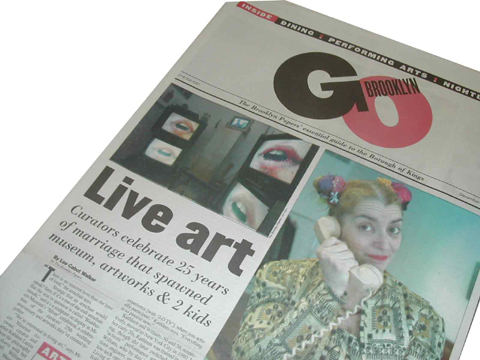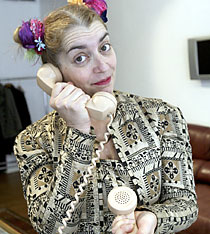 |  |
December 24 2005

LIVE ART
|
|
The Micro Museum's "Silver" exhibition celebraties the fruitful decades of collaboration between artist-curators Kathleen and William Laziza. (At left) Kathleen takes a call from her loveseat, "Phone-I-Ture." .
The Brooklyn Papers / Jori Klein |
|
By Lee Cabot Walker "There is no sincerer love than the love of food," the armchair says.
In 1986, the Lazizas and their then 3-year-old son (they now have two, ages 17 and 22) moved into the second floor of the three-story building at 123 Smith St. In 1997, they bought the building, moving their living space to the third floor, continuing to exhibit art and to rent out rehearsal space on the second floor. In 2002, when the first floor tenant moved out, the Lazizas renovated the space, and the museum moved to its current, street-level location. They continue to rent out the second floor, mainly to performing artists, on an hourly basis. The floor's front room serves musicians and the 19-foot by 38-foot rehearsal space in the back gets used by dancers and martial arts classes. "Artists need a place to be - a place to be understood, a place that's clean," says Kathleen. "I used to practice dance in the East Village, and there would be sewage dripping from the ceiling! Am I going to roll around in that? No way! "It's important to us that people are doing their best work for the world and for New York City. We're really dedicated to that." The Musician's General Store on Court Street rents space at the Micro Museum, where it conducts three classes a week. "Holding music lessons in the Micro Museum has certainly helped us," says Musicians General Store co-owner Mingo Tull. "It's a creative entity, so it's sort of a no-brainer to do music lessons there. I wish we had more venues like that. There's such a lack of facilities to showcase different types of media." The Lazizas pride themselves not only in running a space that helps other artists, but in creating an exhibition space that is family-friendly. "We really pride ourselves on being accessible to children," Kathleen says. The exhibit currently visible through the museum's front window is called "Pond Effect," and incorporates stacked, metallic-colored, cylindrical, plastic building blocks arranged in circles and swirls, placed at floor level so that children can rearrange them. One installation, "Videograph," allows the viewer to manipulate color patterns on an upward-facing TV monitor by placing shapes on the monitor and by spinning the table in which the monitor is embedded. "Videograph" was called an example of "The art of the future" in the New York Times' millennium section on Jan. 1, 2000. Another piece, "Spring Fever," is a collection of about 30 wearable blazers of varying styles that Kathleen "built" by meticulously gluing craft flowers and leaves onto them. The jackets are meant to be worn - often in street performances. One shrug that is completely covered in rose petals took Kathleen 40 hours to create. "We're interested in labor-intensive art," she says. That is also one of the criteria by which the Lazizas evaluate potential exhibitors, with whom the museum is very selective. Highlighted artists in the past have included Stephen Schriver, who made minutely-constructed, detailed collages; J.T., who makes huge paintings covered in "tiny, tiny" peaks of paint; and Kari Ortez, a photographer whose photos represent "highly crafted, bizarre narratives," according to Kathleen. In 2006, Micro Museum debuts a new program, "Open Walls," for which the museum will hold an open call for artists' work every week, and will exhibit a different selection of work each Saturday. "Most museums are for showing the work of dead artists, but we're really looking from the living artist's point of view. What is the artist trying to say?" Kathleen explains. "The name of the museum is metaphoric. It's relatively small - 'micro,' and it's about looking very closely at living artists' work." The museum also produces "Spontaneous Combustion," an arts program that airs on BCAT the third Saturday of every month. "Complete strangers come up to me and say, 'It's so great what you're doing,'" Kathleen says. "The neighbors are very proud. We're like the couple that made good."
On Jan. 7, 2006, Andy Cohen, a pianist and composer, will perform an original work tailored to the "Lumiano" at 2 pm and 4 pm at the Micro Museum (123 Smith St. at Pacific Street in Boerum Hill). Refreshments will be served. The Micro Museum is open to the public Saturdays, from noon to 7 pm. Admission is $2. Admission to all special events is $10; $5 for students and seniors. Event tickets available at the door 15 minutes prior; reservations recommended. |

| Return to Micro Museum |

